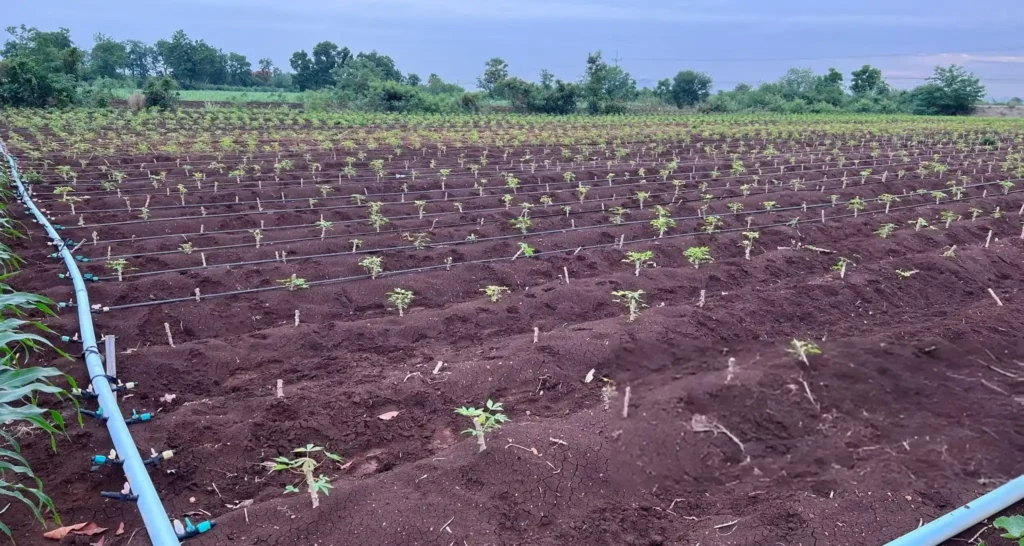Cassava is one of Nigeria’s most valuable crops — a staple food for millions and a raw material for hundreds of industries. With over 45 million metric tons produced yearly, Nigeria remains the world’s largest cassava producer. Yet, despite this potential, fewer than 40% of farmers are operating cassava farms commercially.
If you’re planning to start cassava farming in Nigeria — either as a small-scale grower or as an agribusiness investor — this guide will walk you through every stage, from soil preparation to marketing, including yield expectations, startup costs, and profitability insights.
1. Understanding Cassava and Its Market Potential
Cassava (Manihot esculenta) is a root crop known for its resilience and high carbohydrate content. Beyond garri and fufu, cassava is the foundation of several lucrative industries:
- Food industry: Garri, fufu, cassava flour, chips.
- Industrial use: Starch, HQCF (High-Quality Cassava Flour), adhesives, bioethanol.
- Livestock feed: Cassava peels and chips are processed into feed ingredients.
According to the Nigerian Export Promotion Council (NEPC), the cassava value chain is worth over ₦1 trillion annually — and demand continues to rise, especially for industrial derivatives.
2. Choosing the Right Location and Soil Type
Cassava grows well in most parts of southern and central Nigeria, with the ideal states being:
- Ogun, Oyo, Osun, Ondo
- Kogi, Benue, Kwara
- Enugu, Delta, Edo, Cross River
Ideal conditions:
- Rainfall: 1,000–1,500 mm annually
- Temperature: 25–35°C
- Soil: Loamy or sandy-loam, well-drained
- pH level: Between 5.5 and 7.0
Avoid waterlogged or clay-heavy soil — cassava roots rot easily in such conditions.
3. Land Preparation and Planting
Step 1: Clearing and Tillage
Clear existing vegetation using manual or mechanized tools. Plow and harrow the land at least once to loosen the soil.
Tip: Raised ridges or mounds improve root formation and drainage — especially in southern regions.
Step 2: Selecting Cassava Varieties
Use improved, disease-resistant varieties released by the International Institute of Tropical Agriculture (IITA) or NRCRI Umudike.
Top-performing Nigerian varieties include:
- TMS 30572 – High yield, disease resistant
- TME 419 – Early maturing, popular for garri/flour
- TMS 98/0505 – Good for industrial starch
- TMS 96/1632 – Drought-tolerant, high starch content
Step 3: Planting Method
- Cuttings: Use 20–25 cm long stem cuttings from healthy plants aged 8–14 months.
- Spacing: 1m x 1m (10,000 stands/ha) for food; 0.8m x 0.8m (15,000 stands/ha) for industrial.
- Plant orientation: Slant at a 45° angle, leaving 2–3 nodes above ground.
4. Fertilization and Weed Control
Cassava doesn’t demand excessive fertilizer, but soil nutrients deplete after a few cycles.
Apply the following for best yield:
- NPK (15:15:15): 400–600 kg/ha, 6 weeks after planting.
- Organic manure: Apply poultry droppings or compost before ridging for improved soil structure.
For weed control:
- First weeding: 4–6 weeks after planting.
- Second weeding: 10–12 weeks after planting.
- Use pre-emergence herbicides (e.g., Diuron) sparingly.
Pro tip: Mulching reduces weed pressure and moisture loss — especially during dry months.
5. Pest and Disease Management
Common cassava pests include:
- Cassava mealybug
- Green mite
- Termites
Diseases:
- Cassava mosaic disease (CMD)
- Bacterial blight
- Anthracnose
Control measures:
- Always plant disease-free stems.
- Rotate cassava with legumes like soybean or groundnut.
- Uproot and destroy infected plants immediately.
6. Harvesting and Yield
Cassava matures between 9–15 months depending on the variety.
Indicators for harvest:
- Leaves start yellowing and shedding.
- Stem base becomes woody.
Average yield:
- Traditional varieties: 10–15 tons/ha
- Improved varieties: 25–35 tons/ha
- High-performing farms: up to 45 tons/ha
Harvest manually or mechanically using root diggers.
7. Processing and Value Addition
Instead of selling raw roots (which perish quickly), consider processing cassava for more profit.
Popular value chains:
| Product | Process | Average Market Price (₦) | ROI Margin |
|---|---|---|---|
| Garri | Grating → Fermentation → Frying | ₦800–₦1,200/kg | 40–60% |
| Fufu | Fermentation → Pounding | ₦500–₦800/kg | 30–50% |
| Cassava Flour (HQCF) | Peeling → Drying → Milling | ₦1,000–₦1,300/kg | 50–70% |
| Starch | Extraction → Sedimentation → Drying | ₦900–₦1,200/kg | 40–60% |
Investing in basic processing equipment helps extend shelf life and reach industrial buyers.
8. Profitability Analysis (1 Hectare Example)
| Item | Quantity | Unit Cost (₦) | Total (₦) |
|---|---|---|---|
| Land clearing & prep | 1 hectare | 70,000 | 70,000 |
| Cassava stems (cuttings) | 15,000 | 0.5 | 7,500 |
| Planting labour | – | 25,000 | 25,000 |
| Fertilizer & chemicals | – | 30,000 | 30,000 |
| Weeding & maintenance | – | 40,000 | 40,000 |
| Harvest labour | – | 30,000 | 30,000 |
| Total Cost (₦) | 202,500 |
Revenue:
Average yield = 25 tons (1 hectare)
Market price = ₦40,000/ton → ₦1,000,000 gross revenue
Net Profit: ₦797,500 per hectare (≈300% ROI within 12 months)
9. Marketing Your Cassava Products
To maximize profits:
- Partner with local garri/fufu processors or industrial starch buyers.
- Register on Nigerian export portals (NEPC, NEXIM) to target foreign buyers.
- Attend agriculture expos (AgroNigeria, FMARD events) to find off-takers.
- Build a brand for your products — even simple packaging attracts higher value.
10. Common Mistakes New Farmers Make
- Planting during dry season without irrigation.
- Ignoring soil testing and variety selection.
- Over-reliance on manual processing.
- Poor post-harvest handling leading to spoilage.
- No business or marketing plan before planting.
Remember: Cassava farming is not just planting — it’s agribusiness. The money is made in planning, timing, and processing.
Conclusion
Cassava farming in Nigeria remains one of the most profitable and resilient agricultural ventures today. With improved varieties, better farm management, and access to modern processing, farmers can achieve yields of up to 40 tons per hectare — turning ₦200,000 investments into over ₦1 million returns.
If done right, cassava farming isn’t just a source of income — it’s a gateway to agribusiness prosperity and food security in Nigeria.
Ready to turn your cassava idea into profit?
Join Tanus Agro’s newsletter to get weekly agribusiness insights, cassava buyer updates, and processing tips — straight to your inbox.




